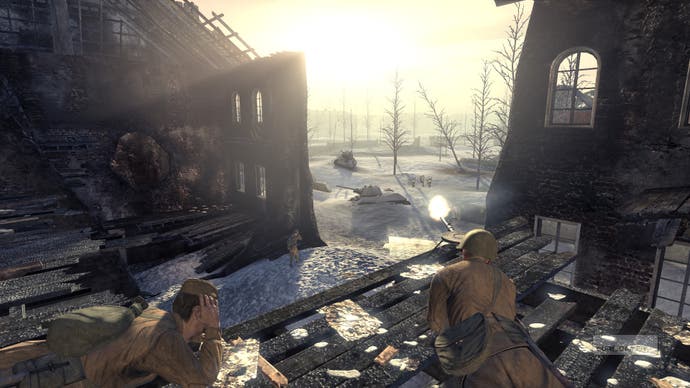Red Orchestra 2: Heroes of Stalingrad
Instruments of war.
Don't know about you, but I'm starting to miss World War II. You'd think my gran might feel differently, yet that doesn't stop her banging on about it. To be fair, she's more concerned with the fact her nation was in mortal danger (alongside who in the village had it away with an American airman, and the banana shortage), so she's probably got justification.
Personally, though, I'm looking back a mere six years to when, statistically, over 60 per cent of shooters involved killing Nazis in the same field of a crepe-heavy region of France.
Back then the world was beginning to tire of World War II, fed up of the endless orders to defend farmhouses with machine gun nests. As the weariness set in, clunking gears were set in motion that led to today's inevitable – and almost universal - switch to modern-day combat.
On the PC, however, one plucky multiplayer shooter never lost its sheen. Its obsession with realism and focus on the less trendy Eastern front kept it different and engaging. Meanwhile, its heart-in-mouth combat and dedication to the real soldier's experience truly made you feel like an active participant in a rubble-strewn nightmare. On some servers, the allure of World War II never quite faded.
So it's good news that Red Orchestra is finally getting a sequel. And it's also going to be a PC-only release. As such it remains free of the temptation to sacrifice its hardcore leanings, or to crowbar the eccentricities of its control system so it works with a gamepad. By my reckoning, it therefore has the potential to rampage through Steam accounts like an authentically recreated Tiger tank with Charlie Sheen at the levers.

Heroes of Stalingrad is a more focussed affair than Ostfront 41-45. The focus is on close-knit battlefields in the Battle of Stalingrad, a set-to between the Germans and the Russians that stretched from July 1942 to February 1943.
Within this battle various authentically recreated locations, like a wrecked train station and a vast grain elevator building, will see game modes like Territory (an attack/defend objective takeover mode, similar to what went before in RO1) and Countdown (a one-life-only timed assault on objectives) play out.
As a sop to newcomers, meanwhile, Firefight will be a class-free Team Deathmatch bullet exchange - albeit with respawns in the near proximity of surviving players, to ensure patterns of attack and resistance.
Within these bouts of 16, 32 or 64 players are game mechanics custom-built to nudge the realism bracket a little closer to authentic mortal danger. They also pepper your game with moments of gut-wrenching panic.

As before, for example, there's no indication of how many rounds you've fired on-screen – you can only get a rough estimation of what's in your clip. You have to mentally gauge just how many bullets you've spent, reload tactically and make an effort to avoid pulling the trigger to be greeted by awkward silence and wobbly knees.
In that instance you're likely to take a few bullets, but when you're shot dead you'll generally get a few seconds of staggering time to let you fire off a shot at your victorious foe. It'll all depend on where you've been perforated, however.
RO2 adheres to locational damage, true ballistics, bullet-drop, accurate levels of scenery penetration and health that won't magically grow back (but bleeding can at least be stymied with a bandage). All of these factor into the realism mix.
When on sniper duty the simple look of your rifle as you dial in your scope is genuinely wonderful, as is the magnified scene slowly edging into focus. There's a new addition to the sniper's assets in the shape of iron-sights which lurk beneath the scope used to pick off close-up enemies - something other shooters should certainly pick up on,


